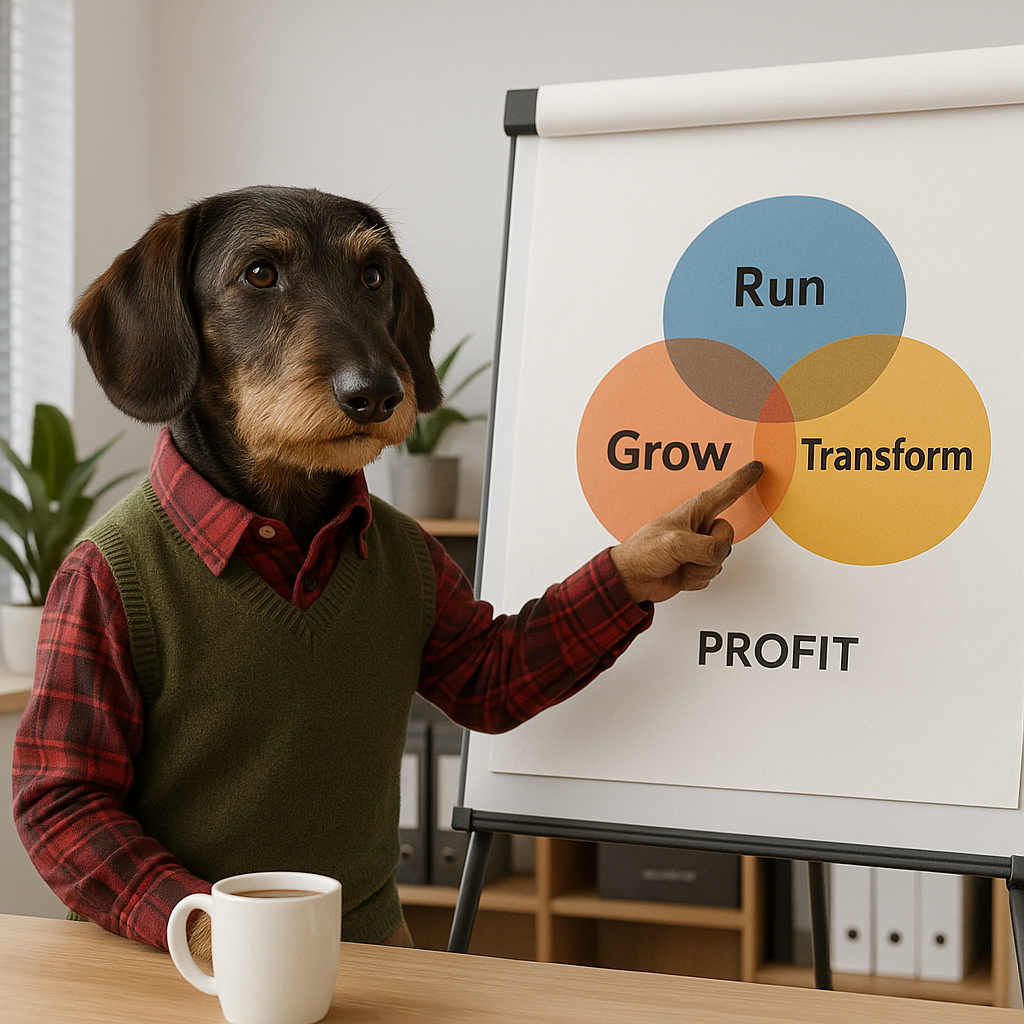Objective Tagging: Gartner's Run / Grow / Transform Modal

This is one of RoadmapOne’s articles on Objective Tagging methodologies .
As a board member, I see a lot of different models that people use to show how the Product and Engineering organisation will be spending their time. In extremis, I’ve seen CPOs who have a cottage industry of people slicing-and-dicing JIRA into complicated models that try to tell the story. But, in my experience, the board want to answer two questions:
- “How much of our resource is spent keeping the lights on versus growing our business?”
- “How much are we spending on more speculative bets that won’t drive growth in this year”
For a lot of boards, the simplest and easiest ways to answer that question is to leverage Gartner’s Run / Grow / Transform (RGT) model. Categorising work as one of these three tags is a great way to demonstrate that you are in-control of resource allocation and your roadmap.

The roadmap above shows how RoadmapOne helps you to instantly understand your roadmap breakdown using our built-in RGT Objective Tagging framework.
We can see that this looks like a fairly well balanced roadmap, with 30% being spent on Run, 51% on Grow and 18% on Transform. Clearly we can drill down and play what-if scenarios, but this is already driving the right discussions.
1. Where Run Grow Transform Came From—and Why It Stuck
Gartner coined RGT in the mid-2000s while analysing IT budgets that were ballooning under the twin pressures of regulatory compliance (Sarbanes-Oxley had just landed) and post-dot-com growth. Boards needed language that felt both financial and strategic. “Run, Grow, Transform” captured that mix:
- Run spend keeps current operations reliable and secure. Think upgrade cycles, bug fixes, and the endless grind of patching.
- Grow spend expands today’s core business into adjacent customers or geographies.
- Transform spend bets on new markets or business models, acknowledging higher uncertainty and longer pay-offs.
Because the terms map to cash-flow timing and risk appetites, CFOs adopted them quickly. Once the finance function cares, the language spreads company-wide.
2. Deep-Diving the Three Buckets
Run: Protecting the Revenue Floor
“Run” is not glamorous, yet a single missed payroll file or security breach can dwarf any flashy new feature (see also Kano Maps ). I regularly see roadmaps that are 100% full of shiny new feature development and I immediately know that the wider organisation will be constantly disappointed with engineering’s need to constantly slip deadlines. Whether you plan for it or not, YOU WILL BE DOING RUN WORK.
Typical items in this space include:
- Sustaining engineering for live products
- Cyber-security hardening
- Cloud cost optimisation
- Making architecture changes to ease subsequent development
- Mandatory regulatory changes (e.g., PSD3 for payment providers)
This is a really important topic, so I strongly encourage you to read our Keeping the Lights On article.
Grow: Extending the Proven Core
Grow initiatives aim for incremental revenue that compounds. They usually:
- Leverage existing technology and brand credibility.
- Reach adjacent segments (new vertical, region, or buyer persona).
- Deliver in 3–12 months, so finance can book forward ARR.
Product managers must articulate clear lagging and leading indicators—for example, partner sign-ups (leading) versus cross-sell MRR (lagging). This transparency reassures boards that Grow work is neither vanity nor Transform in disguise.
Transform: Building for the Future
Transform projects are typically initiaitves that increase our TAM : an AI‐native product line in a historically on-prem company, or a project to expands our business outside our traditional customer base. As Product leaders, we need to be ruthless in ensuring that that we don’t spend too much, or too little time r capital. They demand:
- Dedicated discovery funding to reduce “unknown unknowns.”
- Executive air-cover to shield teams from quarter-to-quarter revenue pressure.
- Explicit kill criteria tied to validated learning, not sunk cost.
When presented well, Transform stories energise investors because they prove leadership isn’t milking a cash cow but cultivating the next one.
A small warning: I’ve also seen organisations where >50% of the resources are focused on highly speculative projects that may or may not deliver value in a 3 year horizon. In a mature organisation, that may well be a huge red flag for investors or the board.
3. Using RGT in Quarterly Portfolio Reviews
Boards rarely object to innovation; they object to opacity. Tagging every roadmap item with an R, G, or T badge gives finance an instant heat-map of runway risk. A typical cadence:
- Baseline the current mix (e.g., 30% Run, 60% Grow, 10% Transform).
- Set guard-rails—say, no less than 15% Transform over a rolling 18-month horizon.
- Track deviations quarterly, just as you do for EBITDA.
Because the language is simple, discussions shift from individual features to portfolio trade-offs. Should we pause a Transform moon-shot to plug a Run security gap? The answer becomes a strategic choice, not a tug-of-war between heads of engineering and product.
4. Day-to-Day Implications for Product Teams
- Backlog triage: During sprint planning, label stories so velocity reports roll up to Run/Grow/Transform dashboards automatically.
- Talent allocation: Rotate senior engineers through Transform squads to cross-pollinate skills.
- OKRs: Tie Run OKRs to reliability metrics, Grow OKRs to expansion revenue, Transform OKRs to validated learning milestones (e.g., “Prove willingness to pay among three design partners”).
5. RGT in RoadmapOne
RoadmapOne lets you add a custom tag group with three mutually exclusive tags. Once enabled, the analytics update in real time. The result: executives see the ratio shift the moment a PM re-tints a card, eliminating the monthly slide-deck grind.
6. Key Takeaways
- Run preserves customer trust; Grow amplifies the core; Transform invents the future.
- Visibility across the three eases board anxiety and protects innovation budgets.
- Automating the tagging workflow in RoadmapOne replaces Excel gymnastics with live, data-driven conversations.
For more on Objective Tagging methodologies, see our comprehensive guide .